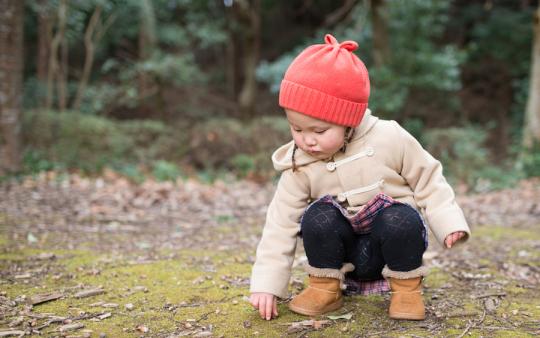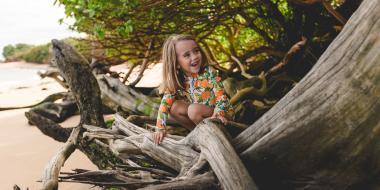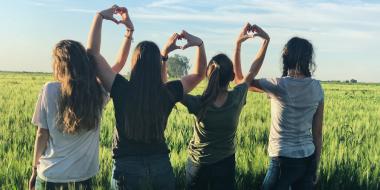There are few things I would rather do than spend time in, on, or near water in the outdoors. As far back as I can remember I have been drawn to lakes, rivers, and oceans. Of all the memories of summers spent swimming and canoe tripping with my family, I remember one section of a northern Ontario canoe trip the most. At a set of rapids linking two lakes we had to line our canoes against the current. Grabbing the bow-end rope I carefully inched forward through the shallow but powerful riverbank water. Waist-deep in sections, each forward push came with the unknown depth and stability of my footing. Standing at less than four feet tall, I plunged down into chest-deep water several times. Like nothing I had felt before, the experience was a mix of excitement and fear. After lining the canoes to the top of the rapids, my cousins and I jumped into the current and floated down the river - over and over again. I had experienced my first outdoor adventure and I was changed. Nature play gives kids these kinds of indelible memories and influences openness to new adventures and ideas.
The experiences we have as children shape our lives. The positive ones fuel our future interests and passions. John Dewey, a renowned researcher in the field of experiential education, believed that the quality of an experience is dependent on both the individual’s immediate reaction and the ongoing influence it may have - an agreeable reaction can leave your mind open to other, similar, opportunities. The long-term impact of short term experiences, such as those inherent in nature play, can be vast.
Experiencing personal growth and development through outdoor activities – particularly in wilderness settings – often fosters an appreciation for the natural environment.
For instance, outdoor adventure helped me realize, at a young age, the importance that positive risk-taking had in my life; I can link each one of my outdoor experiences to ones that came before. In fact, many of my life choices and experiences can in some way be linked to my adventures in the outdoors. Understanding the importance of risk-taking gave me the confidence later in life to make career changes, relocate to a new country, and engage in extreme sports.
Even more significant was my realization that without natural spaces most of my outdoor experiences would never have taken place. This realization was the beginning of my environmental awareness. Experiencing personal growth and development through outdoor activities – particularly in wilderness settings – often fosters an appreciation for the natural environment. Environmental consciousness stems from spending time connecting with nature, leading many people to become, in some fashion, stewards of the Earth.
Conversely, children can just as easily have negative experiences in the outdoors, which may lead to fear and reservation, therefore limiting the chances of connecting with nature. It is important to ease children into outdoor adventure, to identify specific activities they enjoy, and to provide opportunities for them to make transitions between different activities. This variety will expand their fascination with the natural environment.
Children will be motivated if these experiences are fun!
Time spent in nature has health benefits, both physical and emotional. Nature therapy has been receiving increasing attention as a tool that helps to manage attention deficit hyperactivity disorder, stress, anxiety, and depression. Studies have shown that spending time in nature can help with recall and memory, problem-solving, and creativity. Nature has been the platform for many people to discover their abilities and make life-changing breakthroughs.
Organizations such as Outward Bound challenge their clients with outdoor adventure, facilitating skill development, self-discovery, individual growth, and enhanced group dynamics. However, the list of specific physical and mental benefits associated with the outdoors is not likely to motivate young children to engage in nature-based outdoor activities. Rather, children will be motivated if these experiences are fun!
This is where the responsibility of parents, teachers, coaches, and other influential adults comes into nature play. Children often emulate the habits of those around them. Technological entertainment, climate-controlled environments, work pressures, concerns about safety, and a reduction in urban green space influence the habits of many adults. So, as an adult, make a conscious effort to never stop accessing the outdoors as part of your daily routine.
As a parent, always consider the outdoors when planning activities or filling in time between activities. As a teacher who may be overwhelmed by trying to decorate your classroom to stimulate student interest, use the most stimulating “classroom” available and go outside. When I take my students outside for physical education and experiential science classes they immediately become more enthusiastic and aware of their environment. Their smiles are always bigger when the lesson takes place outside.
Outdoor adventure is exciting! Research conducted in 2010 by One Poll in the UK reported that 85% of children age 6-12 were longing for more adventure in their lives with 85% of parents saying adventure should be an important part of their kids' lives. Yet it also reported that 50% of children had never taken part in any adventure sports, and 40% of parents said they didn’t have time or money to partake in adventure activities with their children.
Perhaps this is due, in part, to the fact that adventure is often portrayed as a massive undertaking. Documentary films, best selling books, online blogs, and webcasts bring us along on journeys that push the limits of human physical and emotional capacity. This can certainly make adventure seem intimidating and unreachable, and yet this need not be the case. As a child my adventures in nature were not extravagant. Apart from canoe trips and camping, many of my experiences took place at local parks and lakes with minimal planning required from my parents. These nature play experiences quickly led me to associate nature with adventure and happiness, and it’s like looking in a mirror when I see the same association being made by my three-year-old nephew Aidan on the shores of Georgian Bay.
Over the holidays, I traveled home to Canada to visit my family. Aidan is always on the move. He loves to be active and seems intent on tiring himself out so that he can recharge with a mid-afternoon nap and start again. He gets so much joy from the time he spends outdoors. I think this is the result of being raised by parents who encourage a sense of wonderment and curiosity about the adventures that await him in the backyard of their southern Ontario home. His love of the outdoors is supplemented by road trips to “play” in different parts of the province, and trips to the family cottage each summer, but Aidan’s sense of adventure has been cultivated in simple ways: by exploring the garden in the backyard and the park down the street, by walking local sections of the Bruce Trail system, and spending time in his tree house listening to and learning about the birds that share the branches of his hideout.
The key is not to overthink it, and to use the resources that exist.
Our days are often structured around schedules and deadlines. As a result, it can be challenging for parents to come up with creative ideas for outdoor play. The key is not to overthink it, and to use the resources that exist. Children have an innate interest in exploring, which makes them natural adventurers. They just need the time. For instance, take lunch to go and have a picnic midway through a short hike on a local trail. Dig up a section of the backyard so they can explore the soil and the creatures that might live there. Let them use a magnifying glass to see flowers, blades of grass, and tiny insects close-up. Leave some of the natural vegetation in your backyard for them to play in a less manicured surrounding. This might just stimulate their interest in the forest down the street. Encourage outdoor play with stories about your own childhood and give them the freedom to grass-stain their pants, muddy their hands, and play until dusk when you call them in for bedtime.
For activity ideas, turn to websites like Nature Rocks and The Children & Nature Network. The first website has a “find activities” tool where you can select the amount of time you have available, the type of location, and the age of your children. The result is a list of possible activities. Trying the tool, I entered thirty minutes, my community area, and that my child is between 4 and 6 years old. The tool provided a list of 9 “explore,” 5 “play,” and 1 “get active” activities. Each activity had a description, tips, an application for inviting friends to get involved, and a “find nature” application. This application allowed me to enter a location and the type of activity being planned and then provided an entire list of parks, trails, and other outdoor venues that met my search criteria.
Print resources that can help you plan engaging outdoor activities and adventures include Jennifer Ward’s I Love Dirt!: 52 Activities to Help You and Your Kids Discover the Wonders of Nature, and Joseph Cornell’s Sharing Nature with Children. For insight into the importance of adventures in the outdoors and connecting with the natural environment, Richard Louv’s books are worthwhile reads. His most recent book, The Nature Principle: Human Restoration and the End of Nature-Deficit Disorder, is the follow-up to his highly acclaimed Last Child in the Woods: Saving Our Children from Nature-Deficit Disorder.
Encouraged by recent literature and the abundance of helpful resources aimed at increasing the time children spend in the outdoors, family nature clubs have become increasingly popular. Like-minded parents often initiate these clubs to organize group activities such as orienteering, bird watching, hiking, and building of nature playgrounds. Whatever the activity, the goal is to keep families active in the outdoors and strengthen their bonds with nature and with each other. Search out a group in your area or start your own with some helpful hints from the Children & Nature Network’s Nature Clubs for Families tool kit.
Providing time for children to spend in the outdoors and encouraging a connection with nature is, on many levels, an investment worth making. The movement for greener living and environmentally healthy choices is gaining popularity, especially among younger generations. For this to continue we need inspired, environmentally-minded leaders and eager followers. Protecting our natural world is a responsibility that we inherit the day we are born.
We need to care, and to care we need a connection and an understanding that we are part of the natural environment. We are not watching from the sidelines, we are indeed a part of the adventure!
*Originally published March 1, 2013






